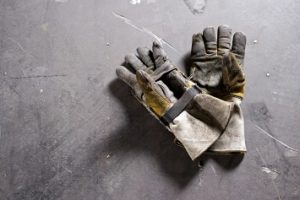The 2016 changes to the American National Standards Institute (ANSI)/International Safety Equipment Association (ISEA) 105 and EN 388—the respective U.S. and European standards for third-party testing of protective gloves—focused mostly on updates to cut-resistance test methods and classifications. But cut resistance isn’t the only protective factor workers need from their work gloves. The ANSI/ISEA 105-2016 standard also provides test methods and performance ratings for other useful protective factors. In Europe, some of these factors are covered under other standards.
Most of these test methods did not receive significant updates in 2016; however, ANSI/ISEA 105-2016 adds a needlestick test method to its puncture resistance ratings.
Abrasion Resistance
ANSI/ISEA 105 rates a material’s abrasion resistance from 0 to 6, with 6 providing the highest protection. The abrasion test methods in EN 388 have been updated; under that standard, glove materials receive an abrasion resistance score of 1–4, with 4 being the most protective material.
Puncture Resistance
The standard puncture resistance test in ANSI/ISEA 105-2016 and EN 388-2016 has not changed, but it uses a thick, blunt-tipped probe that does not approximate needlestick hazards well. So a needlestick puncture test has been added to ANSI/ISEA 105-2016, to address the risk of needlesticks common to the medical, sanitation, and recycling industries. The needlestick test uses a 25-gauge needle, and like the original puncture test, gives a rating of 0 to 5, with 5 being the best puncture resistance in each category.
Chemical Permeation Resistance
EN 388 does not measure chemical permeation; in Europe, that is covered under a different standard, EN 374. The chemical permeation resistance tests have not been updated for ANSI/ISEA 105-2016; the test still gives a rating of 0 to 6, each keyed to a specific breakthrough time (10 minutes for a 0 rating; >480 minutes for a 6 rating). End users should understand that permeation rates are specific to different chemicals. On chemical glove selection charts, the ratings are usually color-coded to enable users to more easily select the best glove for a given chemical exposure or combination of chemical exposures.
Heat and Flame Resistance
Gloves may be flame resistant, resistant to heat degradation, or resistant to conductive heat—each is measured separately. The test methods and ratings found in ANSI/ISEA 105 did not change in 2016. Gloves are rated 0 through 4 for flame resistance and heat degradation, with 4 providing the best protection. For conductive heat resistance, gloves are rated from 0 to 5, with 5 providing the greatest protection.
In Europe, the relevant standard is EN 407, which also covers resistance to radiant heat and molten metal splashes. Gloves are tested and rated in each category from 1 to 4, with 4 being the most protective.
Vibration Reduction
Under the current ANSI/ISEA standard, gloves are classified as pass/fail with respect to vibration resistance. A new standard is in development.
Dexterity and Impact Resistance
Only the Europeans have standards for assessing dexterity and impact resistance. Under EN 420:2009, gloves can be tested and rated from 1 to 5 based on the smallest pin the wearer can pick up. Gloves with a rating of 5 offer the best dexterity.
Likewise, only the Europeans presently offer a testing standard for impact resistance, and it only applies to gloves that claim to provide impact resistance. Like the U.S. standard for vibration reduction, it is pass/fail. A U.S. standard is in development.

